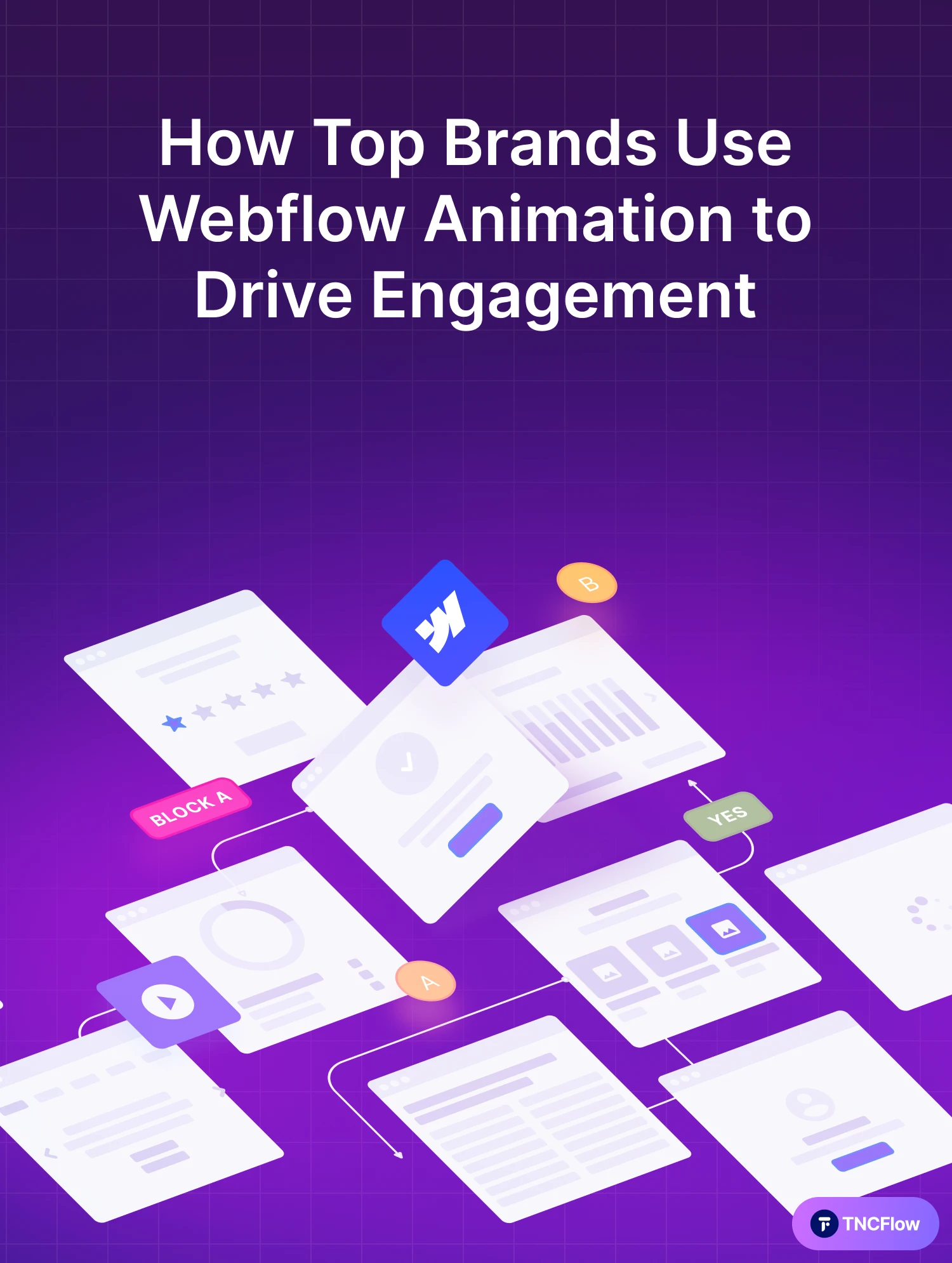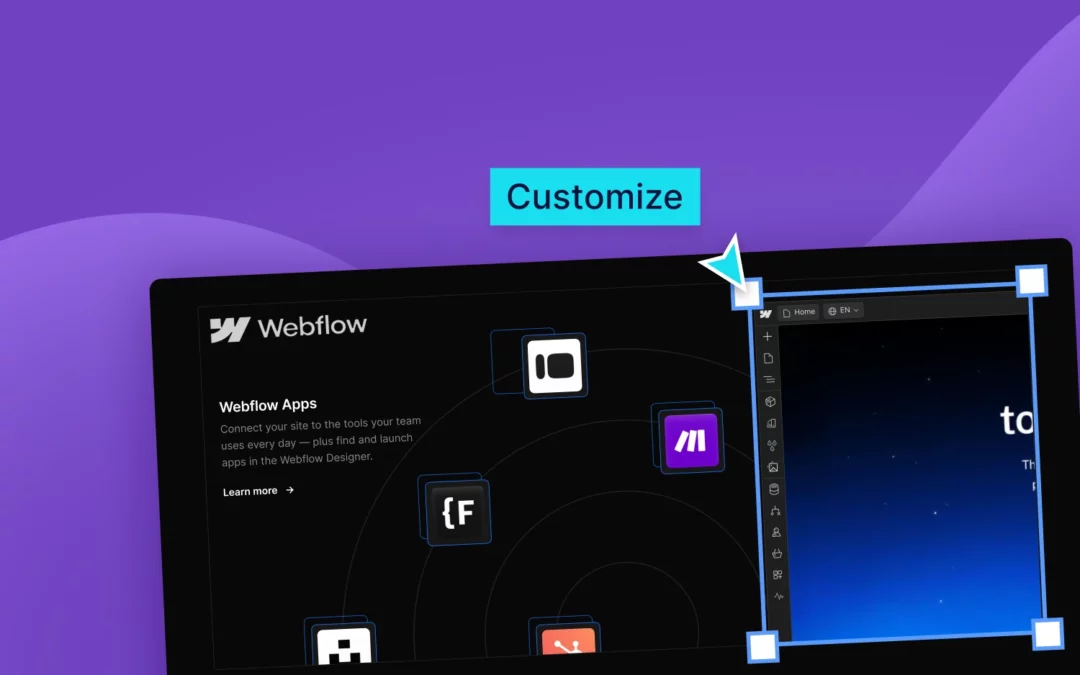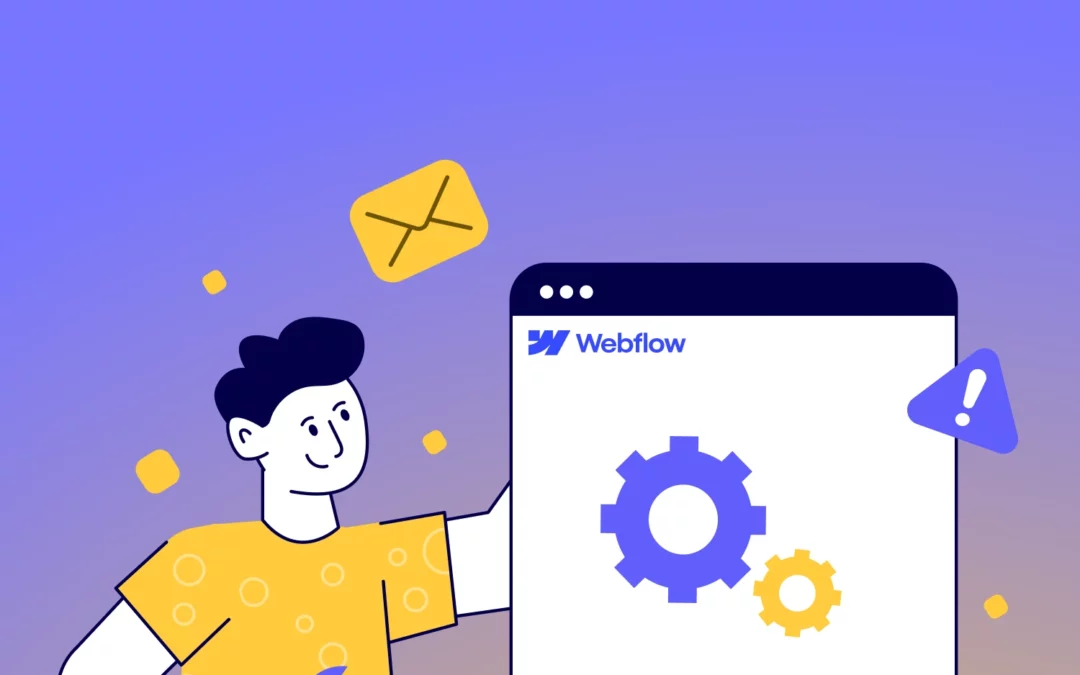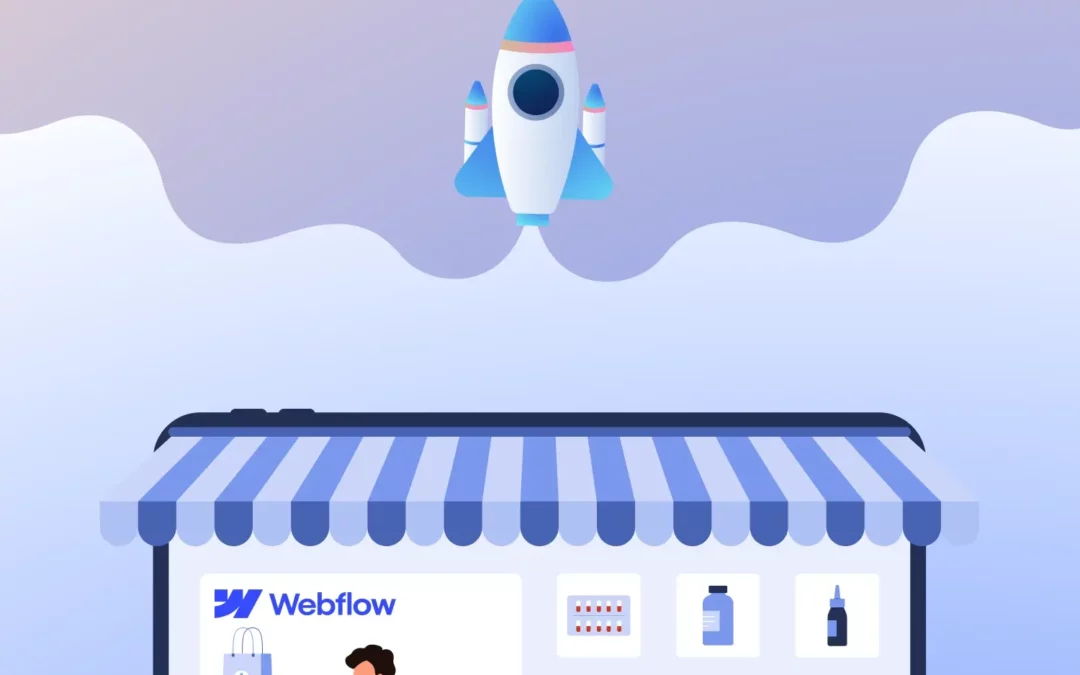Brands that use animations on their Webflow sites see up to 47% higher user engagement and up to 35% lower bounce rates. Visitors expect websites to feel alive, interactive and easy to use. Top brands add animations to their websites that are engaging, tell stories, and guide user behavior. Webflow animations help your website work smoothly while scrolling and make every element animated.
Webflow powers 0.8% of websites worldwide and has a 1.2% CMS market share. Today, all kinds of top brands are using Webflow to create more attractive websites. Visitors love to explore beautifully designed animations and smooth navigation of any website. This blog will show you how leading companies are using Webflow animations to increase engagement. I will show real examples that you can learn from and also show you easy strategies to get started.
Why Do Webflow Animations Matter?
Webflow animations matter because they are powerful tools. It transforms ordinary websites into interactive journeys that visitors love.
- Guide visitors to important parts of the page.
- Make browsing fun and interactive and reduce bounce rates.
- Show product features dynamically instead of just static images.
- Capture and hold attention.
- Build a memorable brand experience.
- Improve user experience (UX).
- Improve conversions and engagement.
- Fully customizable.
- Lead in web design trends with speed and SEO.
Many well-known companies use Webflow animations to make their websites attractive. Here are some real examples:
Life of a Busker
This dynamic music duo’s site uses smooth hover animations on images. Their additional images slide out, giving it a retro magazine feel that matches their art style. Click here to visit their website.
Poura
Poura shows off its natural health drink with a cool animation of the bottle moving smoothly across the screen. As the bottle moves, it interacts with different sections that explain the special ingredients inside. This fun animation helps visitors see and understand the benefits of the drink in interesting way. Click here to visit their website.
The Thirty7
The Thirty7 is a digital marketing agency that makes its website easy to explore by using cool animations on its project images. As users scroll down the portfolio section, the images grow larger or smaller smoothly. Click here to visit their website.
Nursa
Nursa is a healthcare staffing platform that connects healthcare facilities with local nurses and clinicians. Their website uses interactive animations to make it easy for users to browse through large data sets, such as clinician locations and available job listings. Click here to visit their website.
Enjin
A Web3 and NFT platform uses smart animations to make complicated blockchain ideas easy to understand. Instead of just showing lots of technical words, the site uses clear, smooth animations to explain how wallet connections or NFT minting work. Click here to visit their website.
Meter
They use animated storytelling on their long-scroll homepage to simplify complex technical information. As users scroll, smooth animations guide their attention to different sections, turning difficult concepts into simple visual stories. Click here to visit their website.
Implementing Webflow Animations Like Top Brands
Start by planning your story carefully. Think about how users will navigate your web page and what you want them to see at the beginning, during, and end. Then, choose the animation types that best suit your content. This could be hover effects, scrolling animations or 3D movement.
Always test your site speed to make sure animations don’t slow down your site. The page should load in less than 2.1 seconds. Make sure animations work well on mobile devices and are easy to use with touch. Finally, use visitors feedback to improve your animations continuously.
Let’s take a look at a comparison of animation styles: which one works best?
| Animation Type | Best For | User Impact | Example Brands |
| Hover Effects | Subtle interaction cues | Adds interactivity, user delight | Life of a Busker |
| Scroll-triggered Animations | Storytelling & guided flow | Keeps users engaged on journey | Poura, The Thirty7 |
| Interactive 3D Models | Product exploration | Realistic, tactile experience | Grass |
| Cursor Follow Objects | Brand personality and playfulness | Delights and surprises users | Phunk |
| Page Load Transitions | Smooth entry & exit transitions | Creates polished feel | Various top brands |
How to Use Webflow Animation Like Top Brands
1. Scroll-Triggered Animations
Imagine a book where pictures come alive as you turn the pages. That’s how scroll-triggered animations work. When you scroll a website, things appear, move, or change based on how far you scroll. It makes learning and exploring fun with pictures.
How do brands use it?
- Telling a Story: Each scroll shows a new part of the story.
- Showing Product Features: When you scroll past a product, its main features may become animated and visible.
- Lively Backgrounds: The background images might change as you scroll, creating a dynamic feel that reacts to you.
- Making it Feel Real: Perfect for websites about travel, nature, or anything that wants to make you feel like you are in another place.
Example 1: The Grand Entrance: At the beginning of a website, called the hero section, the titles and buttons gradually appear as you scroll down.
Example 2: Features That Show Up As You Scroll: Each feature will be displayed one by one as you scroll down.
Example 3: Parallax Scrolling: In this effect, background images move slower than the front images, creating a cool 3D feeling.
Click here to see an example of a Webflow template.
2. Hover Interactions
Hover animations are all about making your website feel responsive and alive. It subtly changes or animates when you hover your mouse over an element.
How do brands use it?
- Guiding Navigation: When you hover over a menu item, it may change color, become underlined, or expand slightly, indicating that it is clickable.
- Revealing Hidden Information: Hovering over a product image might reveal its price, a short description, or an “Add to Cart” button.
Example 1: Button Changes: When you move your mouse over a button like “Learn More,” the button changes. It might change color, the text slides in, or the button gets a little bigger.
Example 2: Pictures Showing More: In product galleries, pictures change or show extra details when you hover over them.
Example 3: Creative Portfolio Hover: Designers and creative agencies use hover effects on their portfolios. When you move the mouse over a project, it changes or moves.
Click here to see an example of a Webflow template.
3. Entrance Animations
Entrance animations control how elements appear on the screen when the page first loads. Their purpose is to create a good initial impression and draw the user’s attention to important content.
How do brands use it?
- Soft Starts: Elements appear smoothly, not suddenly, for a clean look.
- Focus Guides: Items show up one by one to help users see things in order.
- Build Excitement: A small pause before something shows creates a little surprise.
Example 1. Fade and Slide: When you open a page, the main image slowly appears. Then the headline slides up. Last, the button fades in. This makes the page look smooth and nice.
Example 2. Items Show One by One: If you have a list, each item appears one after another. This keeps it neat and easy.
Example 3. Counting Numbers: Big numbers count up from zero. This grabs attention and looks fun.
Click here to see an example of a Webflow template.
4. Micro-Interactions
Micro-interactions are small, simple animations that happen when you do something on a website. These tiny touches make the website feel smoother and more fun to use.
How do brands use it?
- Show Action Worked: When you click, a button changes to “Sent!” or shows a quick sign that it worked.
- Add Fun Surprises: Small, unexpected animations make the site friendlier and more fun.
- Help Users Know Next Steps: Animations gently guide users on what to do next or what’s happening.
Example 1: Form Submission Feedback: When you click “Submit” on a form, the button might change to a checkmark and say “Sent!” or the form fades out to show “Success!” This lets you know your message was received.
Example 2: Shopping Cart Animation: When you add a product to your cart, the product picture might fly to the cart, or the cart icon shakes or updates the number.
Example 3: Toggle & Checkbox Animation: Switches and checkboxes don’t just flip. They move smoothly.
Click here to see an example of a Webflow template.
5. Background Animations
Background animations create a mood and make your website look nicer. They are soft and always moving. These animations help make your site feel modern and engaging.
How do brands use it?
- Set the mood: Soft, flowing backgrounds can make people feel calm, excited, or creative.
- Add life: Moving backgrounds keep the page feeling alive, especially on long pages.
Example 1: Moving Gradient: Instead of one color, the background slowly changes between soft, matching colors. This gives a fresh and modern look.
Example 2: Floating Shapes: Websites often show soft shapes or tiny particles that float around. These move gently and add depth without being distracting.
Click here to see an example of a Webflow template.
6. Custom Cursor Interactions
Instead of the normal arrow, some websites use a special cursor that changes or grows when you move it. It can also react to items on the page. This makes the site feel unique and full of personality.
How brands use it?
- Show Brand Fun: A playful custom cursor makes your brand feel fun and unique.
- Point Out Clicks: The cursor can change shape to show where to click.
- Make It Enjoyable: A special cursor is a nice surprise that makes browsing more fun.
Example 1: You visit a design studio website. Instead of a simple arrow, your cursor turns into a small bright dot. When you hover over the images, the dot turns into a circle that highlights them.
Example 2: When you hover over text, the cursor changes to a small paintbrush. This makes every click feel special and unique.
Click here to see an example of a Webflow template.
Frequently Asked Questions (FAQ)
Q: What are Webflow animations?
A: Webflow animations are special effects added to website elements that move, change, or respond as users interact with the site.
Q: How do scroll-triggered animations work?
A: They make things appear or move as you scroll down the page, creating a more lively and fun experience.
Q: Do I need to know coding to use Webflow animations?
A: No. Webflow has easy visual tools to create animations without writing code.
Q: What kinds of animations can I make in Webflow?
A: You can add hover effects, scroll animations, custom cursors, button changes, and many more interactive effects.
Q: How can animations help my brand?
A: Animations make your website feel modern, professional, and unique, helping you connect with visitors and stand out from competitors.
Q: Where can I find high-quality Webflow templates?
A: TNCFlow creates top-notch Webflow templates for various industries and niches. You will find them there.

Final thoughts
Top brands use Webflow animations to make websites fun and easy to use. Animations help catch attention and show important info clearly. You can add cool effects like scroll animations, hover effects, and custom cursors without coding. When done right, animations make visitors enjoy the site and want to stay longer. Click here to read more blogs and see Webflow solutions.





Could you expand on the third tip? I’d love to know more.